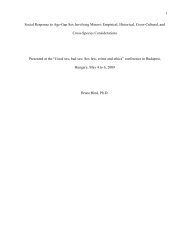Infant and Child Sexuality: A Sociological Perspective - Ipce
Infant and Child Sexuality: A Sociological Perspective - Ipce
Infant and Child Sexuality: A Sociological Perspective - Ipce
Create successful ePaper yourself
Turn your PDF publications into a flip-book with our unique Google optimized e-Paper software.
tion by the young child is accepted also as a normal practise. (Ford<br />
<strong>and</strong> Beach, 1951, p. 188).<br />
Among the Balinese, play <strong>and</strong> teasing with the genitals is common. A<br />
mother will pat her baby girl on the vulva <strong>and</strong> exclaim, “Pretty!<br />
Pretty!” (Bateson <strong>and</strong> Mead, 1942, p. 26, 32, 131). A boy’s penis will<br />
be stroked <strong>and</strong> rubbed. After he has urinated, he will be dried by a<br />
flick of his penis. As he grows older, his penis will be pulled <strong>and</strong><br />
stretched <strong>and</strong> ruffled, <strong>and</strong> he will often attempt to keep his balance<br />
when learning to walk by holding on to it. Babies are comforted <strong>and</strong><br />
quieted by manipulating their genital organs. In fact, in Bali, a baby,<br />
especially a baby’s genital, is a toy with which to play. There is much<br />
delight taken in stimulating <strong>and</strong> playing with the baby to watch him respond.<br />
There has been a strong taboo in the United States on suckling an<br />
infant in public or even reproducing photographs in magazines of infants<br />
suckling; whereas bottle feeding in public <strong>and</strong> pictures of bottle<br />
feeding infants are acceptable. Thus, in America, a young mother<br />
often starts suckling her infant without having once observed another<br />
woman suckling an infant. She is ignorant even if she is interested.<br />
There are marked national differences in breast feeding even in<br />
Western countries as was found in a cross-national study involving London,<br />
Paris, Stockholm, Brussels, <strong>and</strong> Zürich mothers. (As reported in<br />
Newton <strong>and</strong> Newton, 1967). Not only were the overall incidences different,<br />
but significant differences in the type of weaning curves were observed.<br />
Higher breast-feeding rates were associated with high social<br />
status in Zürich <strong>and</strong> Stockholm, but not in Brussels <strong>and</strong> Paris where no<br />
hint of class differences in breast-feeding was noted. British <strong>and</strong><br />
American studies show high social status to be associated with favorable<br />
attitudes toward breast feeding. Sears found that only about twofifths<br />
of the infants in their American study were breast-fed, the<br />
large majority for less than three months. (Sears, et al, 1957, p. 71-<br />
74). The commonest reason given for not suckling the infant was that<br />
the mother was physically unable to do so. Twenty-six percent of the<br />
whole group gave this reason.<br />
Lactation failure or the inability to suckle infants fluctuates<br />
greatly over short periods of time, suggesting that it is triggered by<br />
psychological rather than physiological factors. For instance, national<br />
surveys indicate that the rate of breast-feeding of infants in<br />
the United States fell by almost half during a ten year period. Likewise,<br />
in the course of twenty years in Bristol, Engl<strong>and</strong>, the number of<br />
three-month-old breast-fed infants dropped from 77 to 36 percent. In an<br />
obstetric clinic in France the proportion of babies not suckled increased<br />
from 31 to 51 percent in five years. This change is so rapid<br />
that it cannot be attributed to hereditary factors <strong>and</strong> major physiological<br />
changes in function would be unlikely in the absence of radical<br />
stresses such as starvation or epidemic disease. (Newton <strong>and</strong> Newton).<br />
Western societies raise many barriers against sensory contact between<br />
infant <strong>and</strong> mother. Western styles of female dress calling for<br />
brassieres <strong>and</strong> one or more additional coverings of clothing over the<br />
breasts have made breast-infant contact difficult. Frequently mother<br />
<strong>and</strong> infant do not sleep together in the same bed, or even in the same<br />
room.<br />
15
















